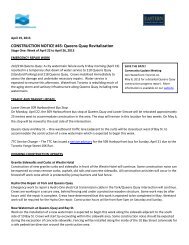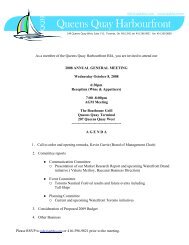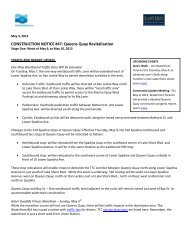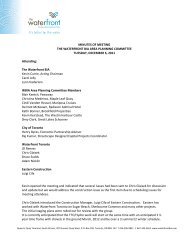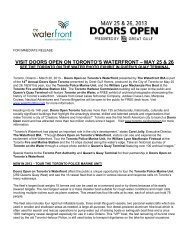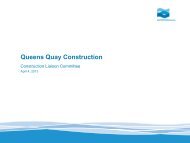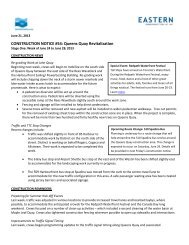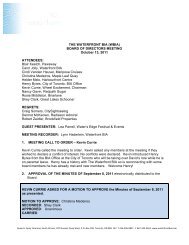Untitled - Waterfront BIA
Untitled - Waterfront BIA
Untitled - Waterfront BIA
You also want an ePaper? Increase the reach of your titles
YUMPU automatically turns print PDFs into web optimized ePapers that Google loves.
TAX COMMITTEE<br />
Toronto’s Tax Plan:<br />
The past year has seen significant developments in the property tax field. First, the City began to<br />
recognize the accuracy of our prediction that the high commercial property tax would ultimately cause<br />
erosion of its tax base. Realizing that commercial development was stalled, and that commercial<br />
property was being transformed to residential development at an accelerating rate, the city sought a<br />
plan to stop, if not reverse, the process. Lacking the political courage to deal with the problem head-on,<br />
the City conjured up a novel approach. It would provide tax relief to commercial property owners by<br />
increasing taxes. We know; it is hard to believe. In effect, the proposal would reduce the ratio between<br />
the commercial and residential rates from its present figure of 4 or 4.5 to 1, to 2.5 to 1. But rather than<br />
reducing the burden on the commercial sector, the proposal calls for increases in both residential and<br />
commercial rates, with the commercial increases limited to one-third of the residential increases. The<br />
scheme proposes a fifteen year time frame for achieving the desired ratio, with a ten year time frame<br />
for what is called the “street retail” sector, a term which has yet to be defined. It does not explain how<br />
further tax increases will stem the outflow of commerce.<br />
Street Retail:<br />
The City’s Finance department said last spring that it is working on a precise definition of “street retail” and<br />
intended to implement the definition for the 2007 taxation year. To date, no definition has been announced.<br />
TA<strong>BIA</strong> has previously made submissions to the City on a proposed definition and indicated that it would<br />
support a definition of the class as “all commercial property with rentable space not exceeding 15,000<br />
square feet”. TA<strong>BIA</strong> would also support a definition with a greater rentable area, up to, but not exceeding<br />
the threshold for the shopping center class or, alternatively, a class consisting exclusively of <strong>BIA</strong> properties<br />
or a class based on retail area if the class were to be extended to include all <strong>BIA</strong> properties.<br />
Acceleration of Full CVA:<br />
From the perspective of our small business membership, the immediate future gets worse. In addition to<br />
rate increases, the City proposes to accelerate the move to full taxation under the Current Value<br />
Assessment regime (CVA). When CVA was implemented in 1998, increases resulting solely from<br />
assessment changes were limited to 2.5% of the prior year’s taxes. This cap was subsequently increased<br />
to five percent of the prior year’s taxes. The City will now change the cap to five percent of a property’s full<br />
CVA level. Accordingly, if a capped property would pay $30,000 at its full CVA tax level, its tax bill would<br />
increase by $1,500 per year until it reached that target. Those increases would be in addition to the rate<br />
increases. Taken together, the rate increases and the cap increases would have many businesses paying<br />
annual tax raises far in excess of the 6.5% raises which have been imposed on them in 2004 and 2005.<br />
The plan and TA<strong>BIA</strong>’s response to it are set out more fully in TA<strong>BIA</strong>’s winter 2006 newsletter (vol. 6 #1).<br />
Provincial Budget:<br />
Over half of the property tax bill is imposed by the provincial government to fund education. But a huge<br />
amount of the provincial levy is used to subsidize education in other parts of Ontario. Particularly<br />
troublesome is the discrepancy between the rate imposed on Toronto business and the corresponding<br />
rate in adjoining municipalities. For example, the 2005 rate in Toronto on commercial property was<br />
2.22%, as compared to 1.74% in Peel, 1.68% in York, 1.65% in Durham and 1.53% in Halton. The<br />
result is the extraction of approximately 120 million dollars of revenue from Toronto business for use<br />
elsewhere. For a small Toronto retailer, the differential can easily run into thousands of dollars.<br />
8



